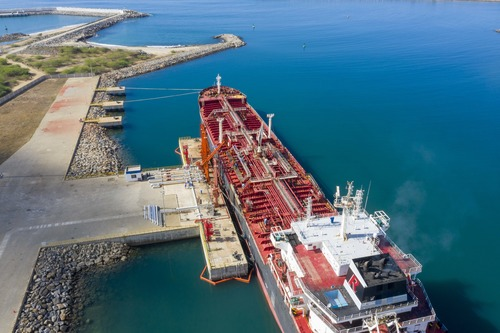BEIJING, June 22 (Xinhua) – Shanghai International Energy Exchange (INE), subsidiary of Shanghai Futures Exchange (SHFE), launched the trading of low sulfur fuel oil futures contracts from Monday, with night trading scheduled to be rolled out on the same day, reported Xinhua-run Shanghai Securities News.
The product, as the second type of future contracts adopting net-price transaction and bonded delivery following crude oil futures in China, marked another approach to internationalization of trading of energy futures contracts.
According to INE, the batch of low sulfur fuel oil futures contracts for trading contains six different ones coded respectively as LU2101, LU2102, LU2103, LU2104, LU2105 and LU2106 and their listing price is 2,368 yuan per tonne.
Trading margin is set at 15 percent of their listing price and daily trading limits are ±13%, with the first day trading limits to be doubled. Transaction fee is two yuan per lot and closing positions opened on the same day will not be exempted from charging transaction fees.
For foreign special non-broker participants and foreign clients, they can use foreign currencies fund as the trading margin. However, foreign currency that can currently be used as the trading margin includes only the U.S. dollar and the discount rate of is 0.95, according to INE.
According to the above parameters, each lot of the low sulfur fuel oil futures contracts values about 23,680 yuan and if trading margin of futures companies is taken into account, it may need about 5,000 yuan of trading margin to trade one lot of the futures contracts, approximately the same as that for fuel oil futures contracts of SHFE and good for improving market liquidity, Wang Xiao, crude oil research director of Guotai Junan Securities, told the newspaper.
As Wang held, launching the internationalized low sulfur fuel oil futures contracts could directly reflect global supply and demand situations and help form a reasonable pricing mechanism for the sector and an influential international pricing center as well.
From January 1 this year, sulfur content requirements for global bunker oil by the International Maritime Organization (IMO) took effect, boosting the further expansion of low sulfur fuel oil spot market and bringing at the same time opportunities and challenges to oil refineries worldwide.
In China, application of export tax rebate policies for low sulfur fuel oil since February 1 this year opened new development space for the country's independent bonded supply of low sulfur bunker oil.
IMO new requirements accelerated the structure shift of the bunker oil market and given the absence of a global pricing center for low sulfur fuel oil at present, China's export tax rebate policies might help it become the biggest producer of low sulfur fuel oil and enhance its say in global low sulfur fuel oil pricing.
Nowadays, global fuel oil production is mainly contributed by the Middle East, South America, Russia, and China, with annual output totaling 500 million tonnes, of which around 300 million to 400 million tonnes are openly traded. Statistics showed that global bunker oil consumption reached 280 million tonnes in recent years and over 45 percent of the aggregate has been consumed by the Asia-Pacific market, making the region the largest bunker oil consuming market. In the region, Singapore is the largest consuming country of global bunker oil, with its 2019 consumption at 47.46 million tonnes. (Edited by Duan Jing with Xinhua Silk Road, duanjing@xinhua.org)




 A single purchase
A single purchase









